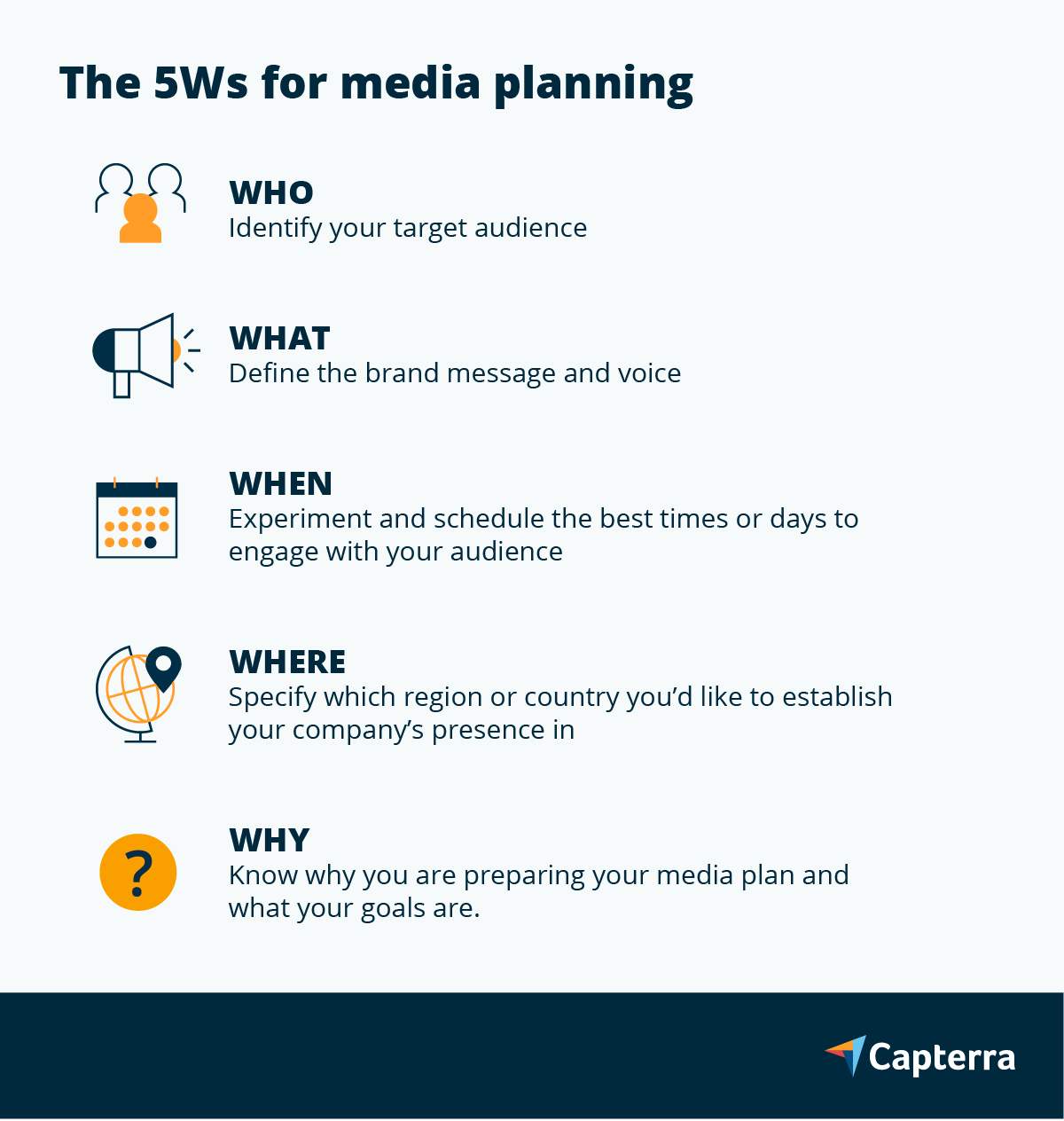Today’s digital landscape is a competitive one. With 2022 around the corner, one of the biggest challenges businesses might face could be how to reach customers effectively using the appropriate media channel. Consumers have more choices than ever before for how and where they want to consume media. To meet such varied needs, many companies may be placing greater emphasis on their media planning process with the help of different marketing planning tools. These tools could potentially help businesses outline marketing strategies, budgets, goals, and measure their effectiveness against various parameters.

In this article, we will talk about what media planning entails, its benefits, and how you can prepare the appropriate media plan for your business. You can also find a free and customisable media plan template that is available to download.
What is media planning?
Media planning is essentially determining when, how, where, and why your business shares media content with the audience. This process includes deciding what media will be shared on which channel to boost your reach, the engagement level of potential consumers (how often and how much they interact with published materials), the return on investment (ROI) you can gain, and more. The goal of a media plan —in general— is to find a good combination of different media channels that would allow your company to communicate its message to the audience in an effective way.
This is especially important in the light of a Google survey, wherein it was found that people chose multiple media channels on their way to buying the things they need, as 91% of Australians interacted with brands via two or more different media channels. The survey further went on to highlight that since the beginning of the pandemic, half of the Australian respondents have either chosen the online mode or are more likely to interact with brands via online channels and hence, they expect brands to meet them where they are.
What are the benefits of media planning?
Strategic media planning can be considered an important tool for making your brand’s message clear to potential customers. A streamlined media plan could give you the opportunity to direct your offerings to the right audience. There are a number of benefits to media planning, some of which are listed below.
Crafting targeted marketing campaigns
During the media planning process, you can potentially get to know your target audience on a deeper level, which could help in reaching out to customers in an effective way via focused and targeted marketing campaigns.
Keeping pace with the latest media trends
As the digital media landscape keeps on upgrading and introducing new trends, it is important to keep pace with new developments, which can be done using a well-researched media plan.
Conducting thorough analyses of your campaigns
You can conduct an analysis of the results of your media planning process and then plan your next marketing campaign accordingly. In this way, you would be able to measure your results and simultaneously improve your marketing strategy for the upcoming time period.
Keeping marketing expenditures in check
You would not want to waste your marketing budget on ads that are not relevant. Media planning could help you plan around your defined budget as you create, publish, and share content. This can also help you remain within your specified budget limit and avoid overspending.
Now, before talking about how you can prepare a suitable media plan for your business, let’s take a look at the five Ws of media planning:

How to prepare an appropriate media plan?
This section focuses on the steps and guidelines you should keep in mind while building the ideal media plan for your business. Please note that results may differ according to company needs and the industry they are being applied to.
Define your media plan objectives
First of all, start by asking yourself why you are doing what you are doing. Why do you have a marketing department in your company? What are you expecting to achieve as your ultimate goal? Here are some examples of the various kinds of objectives companies could have:
- Gaining new followers, readers, and subscribers
- Increasing brand awareness
- Converting potential customers into actionable leads
Businesses should ideally clearly define their objectives before moving on to the next step.
Understand your target audience
Once you have defined your specific goals and objectives, you need to ask yourself who the people whose attention you are seeking are, meaning your target audience. In this step, you should figure out and define your target audiences’ characteristics, their level of engagement, and interests. Businesses which have a wide target audience should focus on a more specific subset for certain key messages to send. For instance, a brand’s Mother’s Day ad would ideally target the children and spouses of women, rather than a generic pool of people.
Specify your preferred media and communication channels
The next step would be to think about which region or country you’d like to establish your company’s presence in, and which channels or platforms would be best suited for you. There are various types of media channels you could choose from, some of which are as follows:
- Owned media include the channels that belong to your company —such as blogs, websites, and social media profiles.
- Earned media include the channels that do not belong to your company but which offer organic (unpaid) or free publicity. This is the type of media wherein your company garners second-hand recognition, such as when your brand is being mentioned in niche blogs, forums, websites, or even social media channels outside your organisation.
- Paid media include the platforms where you can advertise your company or services in exchange for money.
So —while making a plan— you should consider all such channels and choose the ones that would likely work well for you.
Decide on the type of content ideal for each channel
After you’ve decided on the appropriate channel, you should choose which type of content would work best for your business. Visual content such as images, videos, and infographics may be helpful when it comes to grabbing the attention of potential customers on certain specific media channels, including social media.
For example, according to a research article published by Gartner, videos gain more traction than other forms of media. As a result, businesses can also potentially gain from utilising various video marketing software.
Plan your content distribution process and add team roles
At this point, small to midsize enterprises (SMEs) should decide on how often they will produce and share various types of content across their preferred platforms. In addition, businesses should assign roles within the team, specifying which team members will be responsible for which part of the media planning and execution process.
Define your budget
Another significant step in the media planning process is defining your budget. Keeping in mind potential future gains, you should decide what percentage of your budget should be allocated to each campaign. Businesses should also set their annual marketing budget, which should include the costs of all marketing activities such as paid advertising, email marketing, search engine optimisation (SEO), content marketing, and more.
Once your campaign is deployed, you may also be able to analyze measurable goals by tracking engagement via metrics such as click-through rates (CTR) by using different social media analytics tools.
Free media plan template
The benefit of using media planning templates is that you can customise and tailor them according to the specific needs of your business. Keeping this in mind, we’ve put together a media planning template you can download free of charge by clicking on the link given below:
In conclusion
Careful and thorough planning of your marketing activities can help you manage your time more effectively. Moreover, media planning is an important step that can impact your SME’s ability to successfully create, publish, and share content, which is why companies should ideally take their time and build an appropriate media plan to scale their marketing initiatives and enhance brand awareness.

